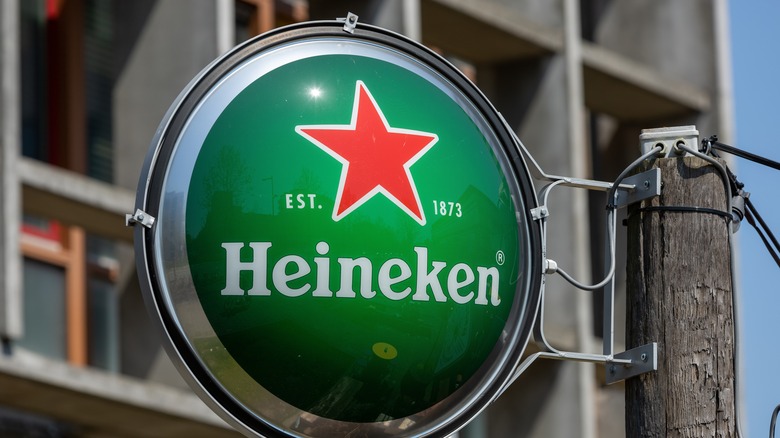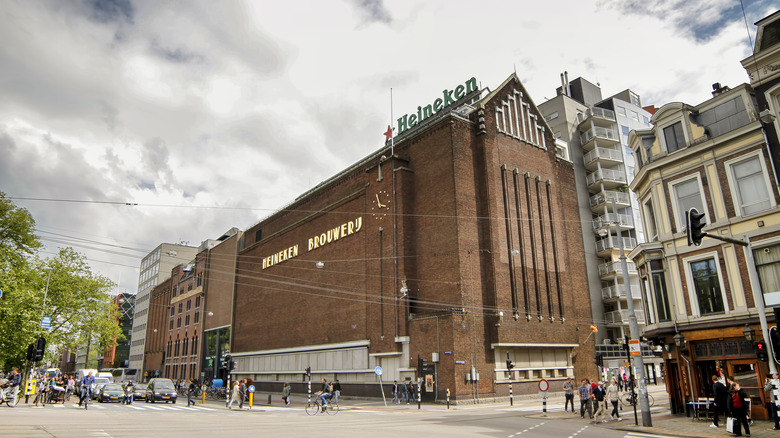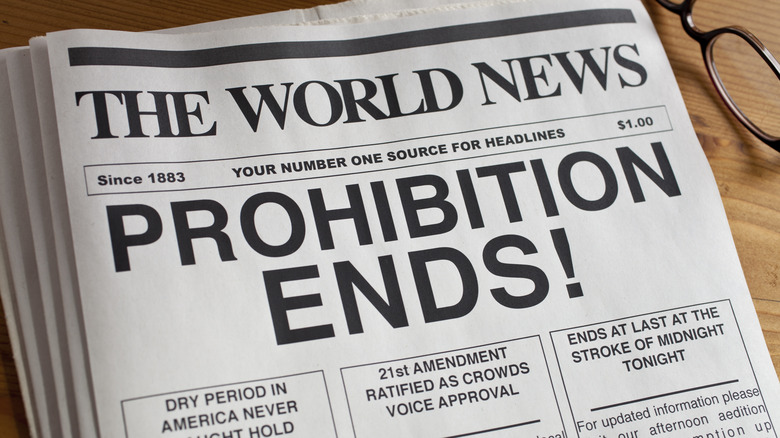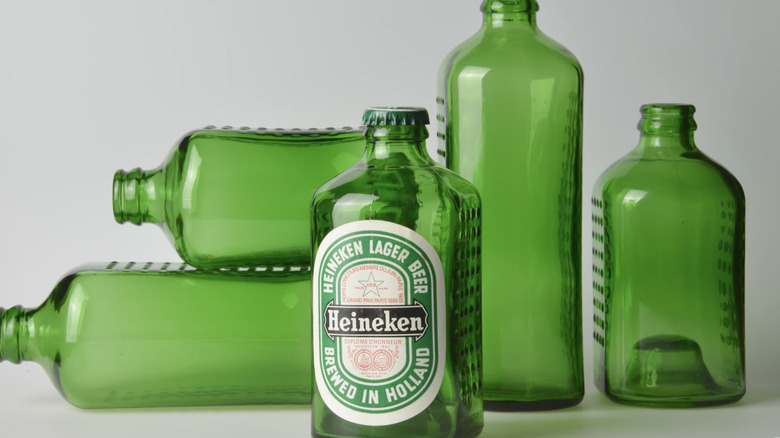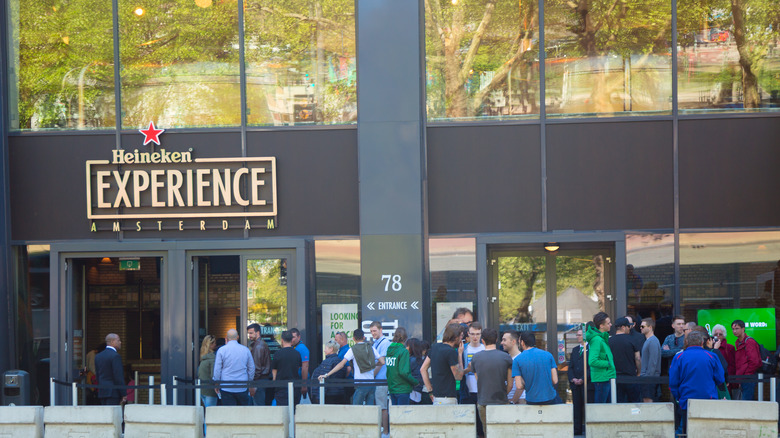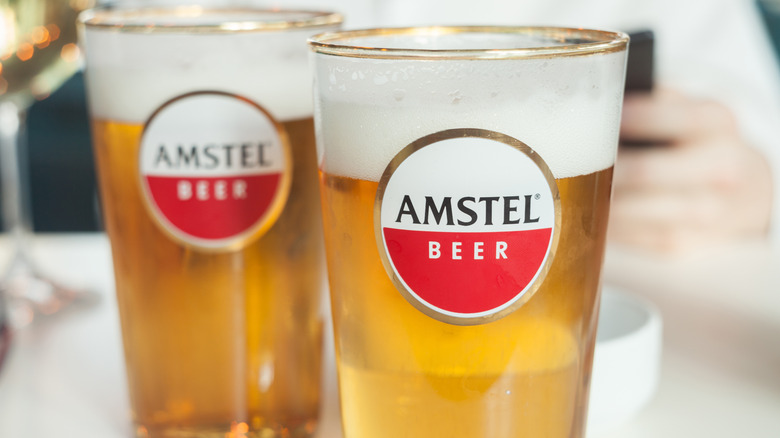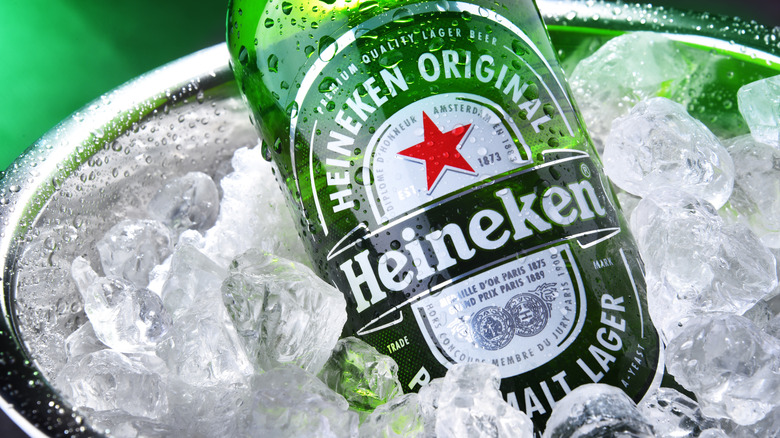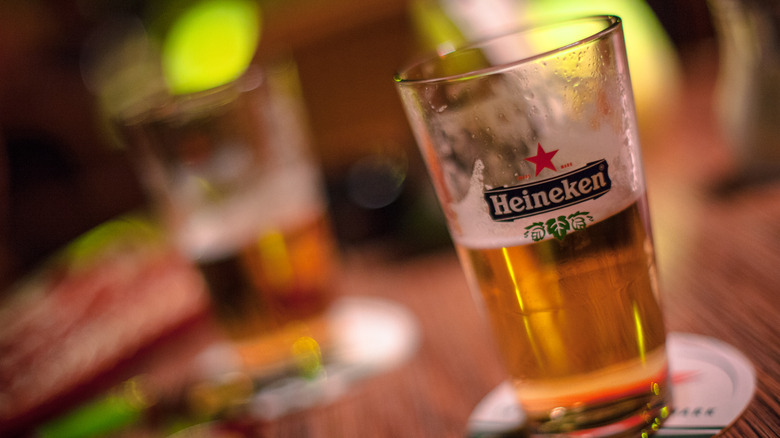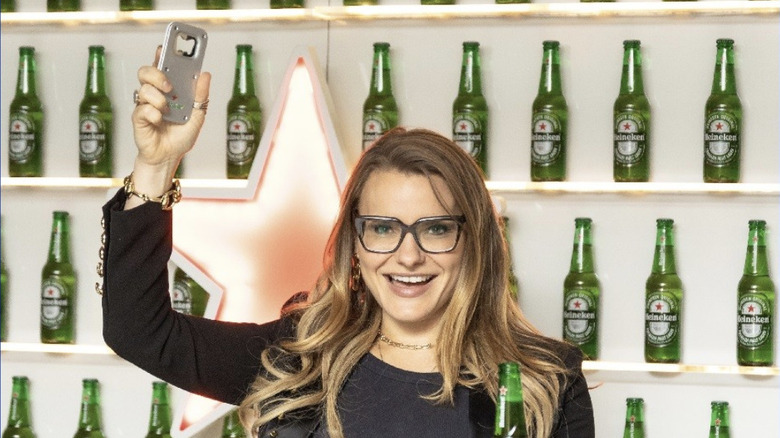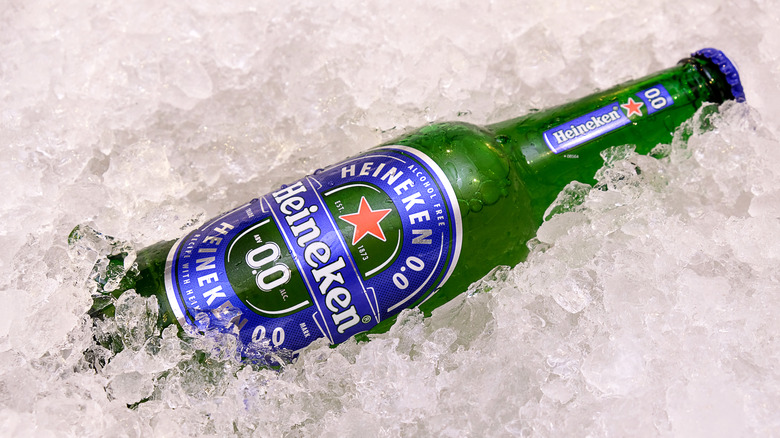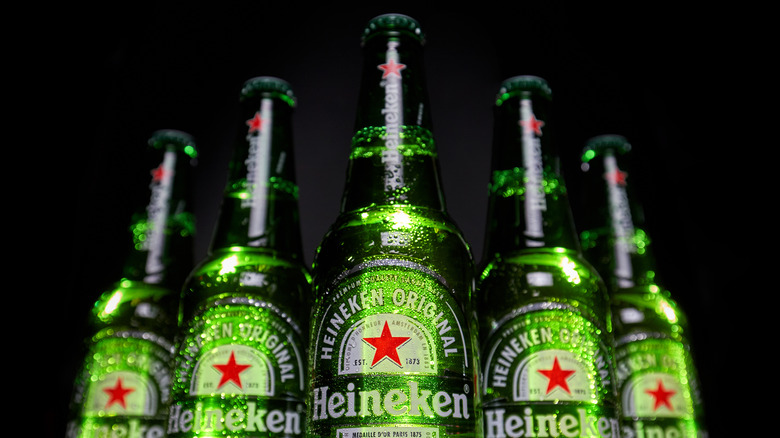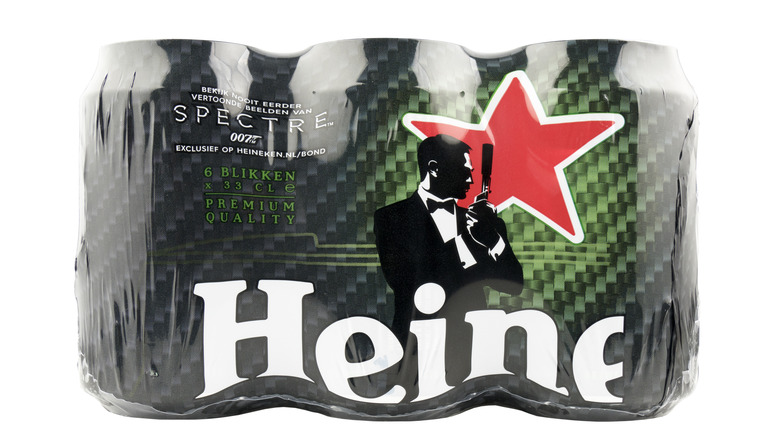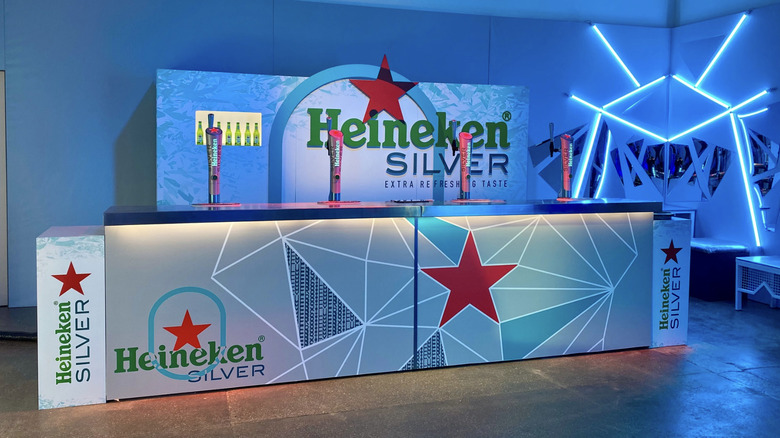Heineken: 12 Facts All Beer Drinkers Need To Know
Heineken is a titan in the global beer industry, boasting an impressive network of 165 breweries across more than 70 nations. Its brews can be enjoyed in over 190 countries. It was the bestselling beer in the world in 2023, according to the Annual Brand Report from Drinks International, and it has distinguished itself as the third highest-selling imported beer in the U.S., following Modelo and Corona, according to 2022 revenue data from Chicago-based Information Resources Inc.
Since its inception in 1873, Heineken has demonstrated remarkable resilience. In an industry marked by constant flux, Heineken's unwavering dedication to quality, inventive marketing strategies, and global expansion has kept this light amber lager in the spotlight, making it as relevant today as ever. Starting from its roots in the Netherlands, Heineken has achieved a feat that eludes many other brands: effectively reaching emerging markets while staying true to its core brand identity.
Despite the fact that Heineken is one of the most recognized and widely consumed beer brands globally, not as many are aware of its fascinating history. We're about to change that. Keep reading to find out more about Heineken's evolution as well as its recipe for success!
Before there was Heineken, there was The Haystack
Heineken wasn't always Heineken. Before the premium Amsterdam brewery came into existence, there was The Haystack or, to be more specific, De Hooiberg. Purchased in 1864 by Gerard Adriaan Heineken, the brewery changed its name to Heineken in 1873 to reflect its new ownership. Despite being just 22 years old at the time of the purchase, Heineken managed to turn the venture into a success by focusing on the latest brewing technology. In addition, he wasn't afraid to defy conventions by brewing only lager at a time when the Dutch were brewing mostly porter and ale.
What is known today as the oldest Heineken brewery is in fact the company's second brewery – Heineken built it in 1873 to replace The Haystack facility purchased nearly a decade earlier. Located in what was then the outskirts of the city, the facility is where the Heineken brand truly came into its own. The same year, Heineken also established another facility in Rotterdam, with both breweries strategically set along the waterfront to enable easier movement of ingredients and products.
Heineken was the first beer exported to the U.S. after Prohibition
Prohibition, which banned the sale and import of all alcoholic beverages in the U.S. beginning in 1920, took a toll on the American people, with its consequences extending beyond mere thirst. While the move aimed to reduce alcohol-related social problems, it inadvertently fueled a surge in the illegal production and distribution of alcoholic beverages and a huge decrease in tax revenue. The ban ended in 1933 due to mounting pressure from various groups and the realization that prohibiting alcohol had created more problems than it had actually solved.
Seeing that the Prohibition was about to end, the leaders at Heineken weren't just going to stand idly by and miss out on the opportunity to tap into the American market. As soon as the ban was lifted, the brewery sent out a ship full of its brew in crates to Hoboken, New Jersey. The historic shipment marked the first importation of beer to the U.S. following Prohibition. Over the next four years, Heineken exports to the U.S. soared, increasing by a staggering 600%, according to the company's history.
Heineken's green bottle was once designed to replace building blocks
Many Americans are familiar with Heineken's distinctive green bottle. However, what they may not realize is that the beer's packaging was once designed to be used as a building block. Unfortunately, Heineken's World Bottle (WOBO), which went into trial production in the 1960s, never took off due to so-called technical issues.
According to the Heineken Collection Foundation, the WOBO bottle was fueled by lofty goals. After visiting what was then known as Dutch Antilles, Alfred Heineken (the grandson of the brewery's founder) was so appalled at the amount of garbage — including Heineken beer bottles — he saw that he decided to do something about it.
Designed in collaboration with architect and director of the Foundation for Architects' Research, John Habraken, the reusable bottle was supposed to serve as a substitute for building bricks. While the first design didn't meet Heineken's expectations, the bottle's second prototype with flat sides and a concave bottom went into trial production in 1964. Heineken even had his own garden house constructed out of the bottles to demonstrate the vessel's versatility. Despite the valiant effort, WOBO's design didn't sit well with the brewery's marketing department, which thought the bottle was not in line with the company's image. The idea seems to have fizzled out over the following years.
The original Heineken brewery in Amsterdam is open to visitors
Amsterdam's original waterfront Heineken brewery remained operational until 1988. Today, the facility hosts the Heineken Experience, offering visitors some insights into the company's history and its beer brewing process. The 1.5-hour self-guided journey encompasses a plethora of fascinating exhibits across four stories. The tour concludes at Best 'Dam Bar where guests can enjoy two frosty glasses of Heineken. Following this, visitors have the opportunity to take an elevator to the building's rooftop where they can admire views of the city.
Some of the highlights of the tour include a peek at one of the brewery's towering 65-foot storage silos that was once used to hold malted barley. Visitors can also see one of the original brewing copper kettles that has been at the facility since 1913 as well as newer kettles installed in 1956. An additional point of interest is a stainless steel fermentation tank from the 1960s, which held a pivotal role in the brewing process. Furthermore, guests may explore an indoor stable and interact with the company's horses that were once responsible for pulling the carts that delivered barrels of beer throughout the city.
Heineken owns hundreds of brands around the world
While the lager in the green bottle may be the company's most popular offering, Heineken owns more than 300 other brands and sells millions of gallons of the golden brew annually across the globe. But it wasn't always that way. When company founder Gerard Adriaan Heineken entered the business in 1864, his brews were available only in the Netherlands.
Heineken has come a long way since selling its first beer internationally in 1875 in France where it was awarded the prestigious "Medaille d'or" at an international exhibition in the Paris Palais d'Industrie. Today, the company's second most popular offering is Amstel, which graces the shelves of more than 110 markets worldwide. Some of the other more notable Heineken-owned beer brands include Mexico's Sol, Singapore's Tiger, Italy's Birra Moretti, and Austria's Edelweiss. Heineken is also the name behind less well-known brews, including Ethiopia's Harar, Namibia's Windhoek, Indonesia's Bintang, Jamaica's Red Stripe, and India's Kingfisher.
But Heineken is not just about beer. It is also the world's top cider maker, as the name behind Strongbow Apple Ciders and Orchard Thieves cider, among others. Heineken also owns Pure Piraña, which makes flavored hard seltzers.
Heineken's label has an interesting backstory
Heineken's lager is recognized by 87% of beer consumers in the U.S., as reported by Statista. This acclaim isn't just thanks to the brew's taste but also due to its characteristic green bottle and label. Nevertheless, what escapes the notice of many is the deeper significance behind Heineken's distinctive label design.
The red star that appears on the Heineken label today has been associated with the brewing of beer since the 14th century. Back in the day, brewers were said to hang the star over their vats, believing that the symbol's protective five points represented fire, earth, water, wind, and an unknown element that some believed was magic. According to another story, the star's five points represent the magic of brewing as well as the four main ingredients used: water, hops, malted barley, and yeast. Interestingly, Heineken changed the color of its iconic star from completely red to white with a red border in 1951, after the symbol became associated with communism. The Heineken star bore the two colors until it was turned completely red again in 1991.
Alfred Heineken's famous motto — "I don't sell beer, I sell enjoyment" — certainly rings true when one delves into the rationale behind the three backward slanted "e"s in the word Heineken on the beer's label. The rounded lowercase letters were supposed to give the impression of smiles and evoke a sense of happiness.
Heineken was wrongly accused of sponsoring a dogfight
In 2012, Heineken found itself in a sticky situation when a photo depicting the company's banners as a backdrop to a dogfight in Mongolia started popping up on the internet. The 2010 image went viral, sparking outrage from both animal activists and the general public who wrongly assumed that Heineken was the sponsor of the event.
Heineken's response was swift and on point. The company was quick to condemn any form of animal cruelty, explaining that the distressing photo was taken at a nightclub in the East Asian country. According to a statement issued by the company, "The venue owner has verbally confirmed that Heineken banners are visible in the pictures because the previous evening the club had been decorated for a promotional event and he had failed to remove the banners once it was over. This event was in no way related to the dog fight. Based on this we have ... ceased our relationship, ensuring our brands will not be available in the club again" (via The Heineken Company).
Heineken released a high-tech bottle opener in 2022
Whether it's a pressing deadline or a project that demands our attention, we often find ourselves extending our workday, determined to accomplish what needs to be done. And whether this may be good for our productivity, it's certainly not great for our mental health. In an effort to combat the growing work-life imbalance, Heineken launched a high-tech bottle opener in 2022 called The Closer. When used to open a bottle (of Heineken), the Bluetooth-enabled gadget automatically closes all of its owner's work applications.
Substantially larger than your average bottle opener, The Closer boasts a sleek, smartphone-like design with a shiny finish and slightly rounded edges. The gadget also features Heineken's iconic red star. The Closer represents the first step in the company's "For a Fresher World" campaign, aimed at promoting a more open-minded approach to life. Perhaps Bruno Bertelli, an executive whose agency was the brains behind the campaign, sums the concept up best by saying in a news release with the launch of the gadget, "As people continue to feel like they have to work all the time, they're forgetting that disconnecting is even an option. That's why we created The Closer. It's not just technology; it's a social provocation to help people see that the pressure to work all the time is getting a little ridiculous" (via PR Newswire).
Heineken offers an alcohol-free version of its beer
With more people embracing health-conscious living, the demand for alcohol-free beverages is also increasing. According to a report by YouGov, the demand for non-alcoholic beer in the U.S. has grown eightfold between 2020 and 2023. Recognizing this trend, Heineken has responded with its very own non-inebriating offering — the Heineken 0.0 Alcohol-Free Lager.
Catering to those seeking the authentic taste of classic Heineken beer without the buzz, Heineken 0.0 utilizes the brand's unique A-yeast formula. This brewing process imbues 0.0 with the characteristic fruity body that Heineken is renowned for while also offering subtle notes of maltiness. The company openly acknowledges the addition of some flavoring to the booze-free brew to compensate for the taste reduction that occurs during the alcohol removal process.
One notable advantage of Heineken 0.0 over its alcoholic counterpart is its low-calorie content. While a standard 12-ounce bottle of Heineken lager contains 142 calories, an 11.2-ounce bottle of Heineken 0.0 only comes with 69 calories.
Heineken has a secret A-yeast formula
When it comes to yeast, the Heineken website proudly proclaims that "there will never be a need for Plan B." This bold declaration encapsulates the brewery's unwavering commitment to the exceptional quality of its secret A-yeast formula. Developed in 1886 by Heineken chemist Hartog Elion, a protege of Louis Pasteur, the strain of yeast has been part of the company's time-honored recipe that continues to play a vital role in the creation of the iconic brew. The yeast strain is not only responsible for the beer's unique flavor but also plays a crucial role in its consistency. Significantly, Heineken's A-yeast won the Grand Prix in 1889 at the Universal Exposition in Paris, a testament to the company's spirit of innovation.
While the A-yeast is still used in Heineken's brewing process, it's not the only strain the company has incorporated into its practices. In 2017, Heineken released a limited-edition brew called H41, which utilized a new yeast strain discovered in Patagonia. Named after the latitude where the yeast was first discovered, H41 was a part of the company's "Lager Exploration" series. So what was the verdict? While probably biased, Willem van Waesberghe, a master brewer at Heineken, has said, "The taste is really the one which blew us away. The spicy note which comes out next to the fruit ... a normal Heineken has this fruity note but by changing the yeast we make this very spicy flavour, a little bit clove like" (via Complex).
Heineken is known for its ingenious advertising campaigns
Over the years, Heineken has shown an ability to not only showcase its beer but also establish profound emotional bonds with consumers. Whether it's through humor, storytelling, or the brand's commitment to fostering connections, Heineken's advertising endeavors have left an indelible mark on the industry. From campaigns such as "A Lockdown Love Story" to "150 Years of Good Times," Heineken has successfully crafted poignant marketing initiatives that have resonated with audiences around the world.
One memorable Heineken advertising move came with the release of the James Bond film "Skyfall" in 2012. Known for his preference for martinis, "shaken not stirred," James Bond (Daniel Craig) took everybody by surprise when he was seen sipping on a chilled Heineken in the movie. The James Bond product placement supposedly cost Heineken a cool $45 million. According to Craig, the film would have never been made had it not been for the financial support provided through partnerships with various companies. "The simple fact is that, without them, we couldn't do it. It's unfortunate but that's how it is," he told Moviefone as quoted by The Guardian.
Heineken launched world's first virtual beer in 2022
For those of us not clued in, the metaverse is a virtual space where internet users can interact with each other and digital objects. In 2022, Heineken used this computer-generated environment to release the first-ever virtual beer. Hosted on the virtual world platform Decentraland, this innovative product marked a significant milestone in the integration of virtual reality into the sphere of marketing.
According to PR Newswire, Heineken Silver was crafted using "Binary Coded Hops grown by NPC (non-player character) farmers." The product launch took place at Heineken's virtual brewery, where attendees had the opportunity to learn about the brewing process as they feasted their eyes on digital lobster and caviar. Luckily, beer enthusiasts can taste Heineken Silver in the real world, where the premium lager is brewed at a cool 30 degrees Fahrenheit.
Heineken representatives were quick to highlight that the event and the pixelated beer were an "ironic joke." Bram Westenbrink, global head of the Heineken brand, explained in a statement: "It is a self-aware idea that pokes fun at us and many other brands that are jumping into the metaverse with products that are best enjoyed in the real world. For now, you can't taste pixels and bytes. So, we want to make a joke about that and remind everyone that nothing beats the taste of a refreshing beer, including our new virtual Heineken Silver, in the real world" (via PR Newswire).
